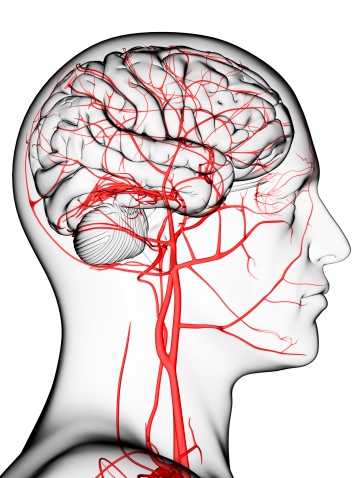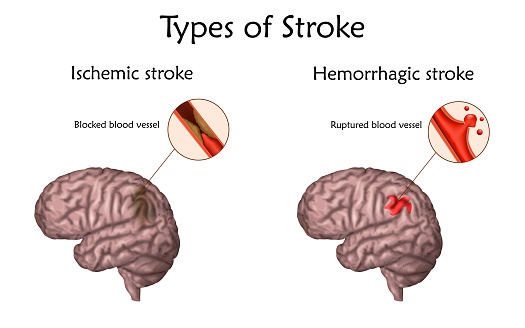Understanding Stroke

Stroke is a type of cerebrovascular disease. “Cerebro” refers to the brain and “vascular” to arteries and veins. Strokes occur when blood flow to the brain is disrupted because a blood vessel is blocked by a clot; narrowed; or ruptured. It’s important to know:
- Stroke is a medical emergency. If you suspect a stroke, call 911 and get treatment as soon as possible. Learn the signs of stroke.
- Although stroke is a leading cause of long-term disability, it is also highly preventable.
- At OHSU, our stroke specialists use state-of-the-art imaging to rapidly diagnose stroke. We offer optimal treatments for even the most complex cases.
What is stroke?
A stroke, or brain attack, happens when blood flow to the brain is disrupted. Most often, a clot blocks a blood vessel and stops blood from reaching parts of the brain. Less often, a blood vessel in or near the brain bursts.
Blood carries oxygen and nutrients to the brain. When blood flow is disrupted, brain cells start to die within minutes, and a stroke occurs.
Strokes have different effects depending on where in the brain they happen and how much brain tissue is damaged. Strokes can cause problems with:
- Movement
- Muscle control
- Thinking
- Memory
- Speech
In addition, a small stroke can lead to temporary weakness in an arm or leg. A larger stroke can cause permanent loss of speech; paralysis on one side of the body; or death.
Who has strokes?
Every year, more than 795,000 people in the U.S. have a stroke. Stroke is the fifth-leading cause of death in the U.S. and the leading cause of long-term disability.
Risk factors include:
- Age: People of any age can and do have strokes, but risk doubles every decade after 55.
- Gender: Stroke is more common in women, partly because they live longer. Pregnancy, birth control pills and hormone therapy also increase risk. Women are more likely to die from stroke.
- Race: Black people, Latinos, Alaska Natives and Native Americans have a higher risk of stroke. Black Americans are twice as likely as white Americans to die from stroke.
- Family and health history: People are at greater risk if they’ve had a stroke or have a family history of stroke. Having certain blood disorders also increases risk.
You can reduce your risk of stroke by taking medication and making lifestyle changes. Risk factors that can be controlled include:
- High blood pressure
- High cholesterol
- Smoking
- Drinking too much alcohol
- Being overweight
- Unhealthy diet
- Not getting enough exercise
- Heart disease; atrial fibrillation (irregular heartbeat) in particular can cause blood clots
- Atherosclerosis (fatty deposits in arteries)
- Diabetes
Signs and symptoms
Call 911 if you or someone you are with has sudden:
- Weakness or numbness in the face, arm or leg
- Loss of vision or double vision
- Trouble talking, understanding others or slurred speech
- Spinning sensations or dizziness
- Loss of balance or coordination
- Severe headache (less common)
Read more about stroke symptoms.

Types of stroke
Ischemic
Ischemic stokes happen when a clot blocks an artery, stopping blood from reaching parts of the brain. Most strokes (87%) are ischemic. There are two subtypes:
- Thrombotic: A clot (thrombus) forms in an artery that supplies blood to the brain. This type is often linked to plaque (fatty deposits) in arteries (artherosclerosis). Plaque buildup is a particular problem in the carotid arteries, which run up each side of the neck to the brain.
- Embolic: A clot (embolus) forms outside the brain, often in the heart. It’s carried through the bloodstream to the brain, where it becomes lodged in a blood vessel.
Hemorrhagic
Hemorrhagic strokes account for 13% of strokes. They occur when a weakened blood vessel in or around the brain bursts. Blood spills into the brain or the area surrounding it. The pooling blood deprives parts of the brain of oxygen and nutrients. It also puts harmful pressure on the brain. Hemorrhagic strokes are classified according to where the bleeding (hemorrhage) happens:
- Intracerebral hemorrhage: An artery within the brain bursts, and blood spills into surrounding brain tissue. High blood pressure is often the cause. This is the more common type.
- Subarachnoid hemorrhage: An artery on the underside of the brain bursts and spills blood into the area between the brain and skull (subarachnoid space). This type can happen when an aneurysm (a weak or ballooning spot in an artery wall) ruptures.
Transient ischemic attack
A transient ischemic attack, or TIA, happens when blood flow to the brain is briefly interrupted. Stroke symptoms may last only a few minutes. Symptoms are gone within 24 hours with no permanent damage.
Transient ischemic attacks are often a sign that arteries are clogged and that a stroke could follow. A TIA is a medical emergency and should not be ignored.
Related disorders
Brain aneurysm: A brain aneurysm (also called a cerebral aneurysm) is a ballooning, weakened area in an artery, a blood vessel that carries blood to the brain. If it bursts, it can lead to stroke.
Arteriovenous malformation or AVM: This is an abnormal tangle of blood vessels in or on the brain. Weak blood vessel walls and abnormal connections between arteries and veins make AVMs prone to rupture, which can lead to stroke.
For patients
- Call 911 now if you or someone else may be having a stroke. Learn the BE FAST signs of stroke.
- Referral: To become a patient, please ask your doctor for a referral.
- Questions: For questions or follow-up appointments, call 503-494-7772.
Location
Parking is free for patients and their visitors.
OHSU Stroke Program clinic
Hatfield Research Center, 13th floor
3250 S.W. Sam Jackson Park Road
Map and directions
Refer a patient
- Refer your patient to OHSU.
- Call 503-494-4567 to seek provider-to-provider advice.
- Find OHSU’s stroke practice standards on our For Health Care Professionals page.
Patient resources
- Find resources for patients and families.
- Learn about stroke prevention.
- Learn how our Telemedicine Network can bring OHSU expertise to your community.